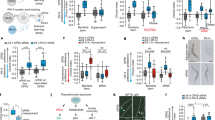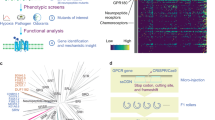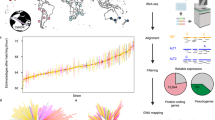Abstract
Heritable variation in behavioural traits generally has a complex genetic basis1, and thus naturally occurring polymorphisms that influence behaviour have been defined only in rare instances2,3. The isolation of wild strains of Caenorhabditis elegans has facilitated the study of natural genetic variation in this species4 and provided insights into its diverse microbial ecology5. C. elegans responds to bacterial infection with conserved innate immune responses6,7,8 and, although lacking the immunological memory of vertebrate adaptive immunity, shows an aversive learning response to pathogenic bacteria9. Here, we report the molecular characterization of naturally occurring coding polymorphisms in a C. elegans gene encoding a conserved HECT domain-containing E3 ubiquitin ligase, HECW-1. We show that two distinct polymorphisms in neighbouring residues of HECW-1 each affect C. elegans behavioural avoidance of a lawn of Pseudomonas aeruginosa. Neuron-specific rescue and ablation experiments and genetic interaction analysis indicate that HECW-1 functions in a pair of sensory neurons to inhibit P. aeruginosa lawn avoidance behaviour through inhibition of the neuropeptide receptor NPR-1 (ref. 10), which we have previously shown promotes P. aeruginosa lawn avoidance behaviour11. Our data establish a molecular basis for natural variation in a C. elegans behaviour that may undergo adaptive changes in response to microbial pathogens.
This is a preview of subscription content, access via your institution
Access options
Subscribe to this journal
Receive 51 print issues and online access
$199.00 per year
only $3.90 per issue
Buy this article
- Purchase on Springer Link
- Instant access to full article PDF
Prices may be subject to local taxes which are calculated during checkout




Similar content being viewed by others
References
Flint, J. & Mackay, T. F. Genetic architecture of quantitative traits in mice, flies, and humans. Genome Res. 19, 723–733 (2009)
Bendesky, A., Tsunozaki, M., Rockman, M. V., Kruglyak, L. & Bargmann, C. I. Catecholamine receptor polymorphisms affect decision-making in C. elegans. Nature 472, 313–318 (2011)
Osborne, K. A. et al. Natural behavior polymorphism due to a cGMP-dependent protein kinase of Drosophila. Science 277, 834–836 (1997)
Barrière, A. & Félix, M. A. Natural variation and population genetics of Caenorhabditis elegans in WormBook (ed. The C. elegans Research Community) doi/10.1895/wormbook.1.43.1. (2005)
Félix, M. A. & Braendle, C. The natural history of Caenorhabditis elegans. Curr. Biol. 20, R965–R969 (2010)
Kim, D. H. et al. A conserved p38 MAP kinase pathway in Caenorhabditis elegans innate immunity. Science 297, 623–626 (2002)
Mallo, G. V. et al. Inducible antibacterial defense system in C. elegans. Curr. Biol. 12, 1209–1214 (2002)
Nicholas, H. R. & Hodgkin, J. The ERK MAP kinase cascade mediates tail swelling and a protective response to rectal infection in C. elegans. Curr. Biol. 14, 1256–1261 (2004)
Zhang, Y., Lu, H. & Bargmann, C. I. Pathogenic bacteria induce aversive olfactory learning in Caenorhabditis elegans. Nature 438, 179–184 (2005)
de Bono, M. & Bargmann, C. I. Natural variation in a neuropeptide Y receptor homolog modifies social behavior and food response in C. elegans. Cell 94, 679–689 (1998)
Reddy, K. C., Andersen, E. C., Kruglyak, L. & Kim, D. H. A polymorphism in npr-1 is a behavioral determinant of pathogen susceptibility in C. elegans. Science 323, 382–384 (2009)
Pradel, E. et al. Detection and avoidance of a natural product from the pathogenic bacterium Serratia marcescens by Caenorhabditis elegans. Proc. Natl Acad. Sci. USA 104, 2295–2300 (2007)
Pujol, N. et al. A reverse genetic analysis of components of the Toll signaling pathway in Caenorhabditis elegans. Curr. Biol. 11, 809–821 (2001)
Shivers, R. P., Kooistra, T., Chu, S. W., Pagano, D. J. & Kim, D. H. Tissue-specific activities of an immune signaling module regulate physiological responses to pathogenic and nutritional bacteria in C. elegans. Cell Host Microbe 6, 321–330 (2009)
McGrath, P. T. et al. Quantitative mapping of a digenic behavioral trait implicates globin variation in C. elegans sensory behaviors. Neuron 61, 692–699 (2009)
Weber, K. P. et al. Whole genome sequencing highlights genetic changes associated with laboratory domestication of C. elegans. PLoS ONE 5, e13922 (2010)
Chang, A. J., Chronis, N., Karow, D. S., Marletta, M. A. & Bargmann, C. I. A distributed chemosensory circuit for oxygen preference in C. elegans. PLoS Biol. 4, e274 (2006)
Gray, J. M. et al. Oxygen sensation and social feeding mediated by a C. elegans guanylate cyclase homologue. Nature 430, 317–322 (2004)
Reddy, K. C., Hunter, R. C., Bhatla, N., Newman, D. K. & Kim, D. H. Caenorhabditis elegans NPR-1-mediated behaviors are suppressed in the presence of mucoid bacteria. Proc. Natl Acad. Sci. USA 108, 12887–12892 (2011)
Miyazaki, K. et al. NEDL1, a novel ubiquitin-protein isopeptide ligase for dishevelled-1, targets mutant superoxide dismutase-1. J. Biol. Chem. 279, 11327–11335 (2004)
Tsalik, E. L. et al. LIM homeobox gene-dependent expression of biogenic amine receptors in restricted regions of the C. elegans nervous system. Dev. Biol. 263, 81–102 (2003)
Perkins, L. A., Hedgecock, E. M., Thomson, J. N. & Culotti, J. G. Mutant sensory cilia in the nematode Caenorhabditis elegans. Dev. Biol. 117, 456–487 (1986)
Kaplan, J. M. & Horvitz, H. R. A dual mechanosensory and chemosensory neuron in Caenorhabditis elegans. Proc. Natl Acad. Sci. USA 90, 2227–2231 (1993)
Sawin, E. R., Ranganathan, R. & Horvitz, H. R. C. elegans locomotory rate is modulated by the environment through a dopaminergic pathway and by experience through a serotonergic pathway. Neuron 26, 619–631 (2000)
Macosko, E. Z. et al. A hub-and-spoke circuit drives pheromone attraction and social behaviour in C. elegans. Nature 458, 1171–1175 (2009)
Dethlefsen, L., McFall-Ngai, M. & Relman, D. A. An ecological and evolutionary perspective on human–microbe mutualism and disease. Nature 449, 811–818 (2007)
Brenner, S. The genetics of Caenorhabditis elegans. Genetics 77, 71–94 (1974)
Mello, C. C., Kramer, J. M., Stinchcomb, D. & Ambros, V. Efficient gene transfer in C. elegans: extrachromosomal maintenance and integration of transforming sequences. EMBO J. 10, 3959–3970 (1991)
Frøkjær-Jensen, C. et al. Single-copy insertion of transgenes in Caenorhabditis elegans. Nature Genet. 40, 1375–1383 (2008)
Tan, M. W., Mahajan-Miklos, S. & Ausubel, F. M. Killing of Caenorhabditis elegans by Pseudomonas aeruginosa used to model mammalian bacterial pathogenesis. Proc. Natl Acad. Sci. USA 96, 715–720 (1999)
Acknowledgements
We thank D. Denning and H. R. Horvitz for the csp-1b cDNA. We thank Y. Kohara for the hecw-1 and npr-1 cDNAs. We thank J. Meisel for sequencing of hecw-1 polymorphisms. We thank D. Ma for technical advice on laser ablation. We thank T. Schwartz for expert advice with the structural modeling of HECW-1. The hecw-1(ok1347) deletion allele was generated by the C. elegans Knockout Consortium and obtained, along with other strains used in this study, from the Caenorhabditis Genetics Center (CGC), which is supported by the NIH—National Center for Research Resources. This work was supported by NIH Grant GM084477 (to D.H.K.).
Author information
Authors and Affiliations
Contributions
H.C.C. and D.H.K. designed experiments, H.C.C. and J.P. performed experiments, H.C.C. and D.H.K. analyzed and interpreted the data, and H.C.C. and D.H.K. wrote the paper.
Corresponding author
Ethics declarations
Competing interests
The authors declare no competing financial interests.
Supplementary information
Supplementary Information
The file contains Supplementary Table 1, Supplementary Figures 1-8 with legends and additional references. (PDF 2594 kb)
Rights and permissions
About this article
Cite this article
Chang, H., Paek, J. & Kim, D. Natural polymorphisms in C. elegans HECW-1 E3 ligase affect pathogen avoidance behaviour. Nature 480, 525–529 (2011). https://doi.org/10.1038/nature10643
Received:
Accepted:
Published:
Issue Date:
DOI: https://doi.org/10.1038/nature10643
This article is cited by
-
Wild-type Caenorhabditis elegans isolates exhibit distinct gene expression profiles in response to microbial infection
BMC Genomics (2022)
-
C. elegans: out on an evolutionary limb
Immunogenetics (2022)
-
Host genotype and genetic diversity shape the evolution of a novel bacterial infection
The ISME Journal (2021)
-
Ubiquitin-related processes and innate immunity in C. elegans
Cellular and Molecular Life Sciences (2021)
-
Polymodal Functionality of C. elegans OLL Neurons in Mechanosensation and Thermosensation
Neuroscience Bulletin (2021)
Comments
By submitting a comment you agree to abide by our Terms and Community Guidelines. If you find something abusive or that does not comply with our terms or guidelines please flag it as inappropriate.



